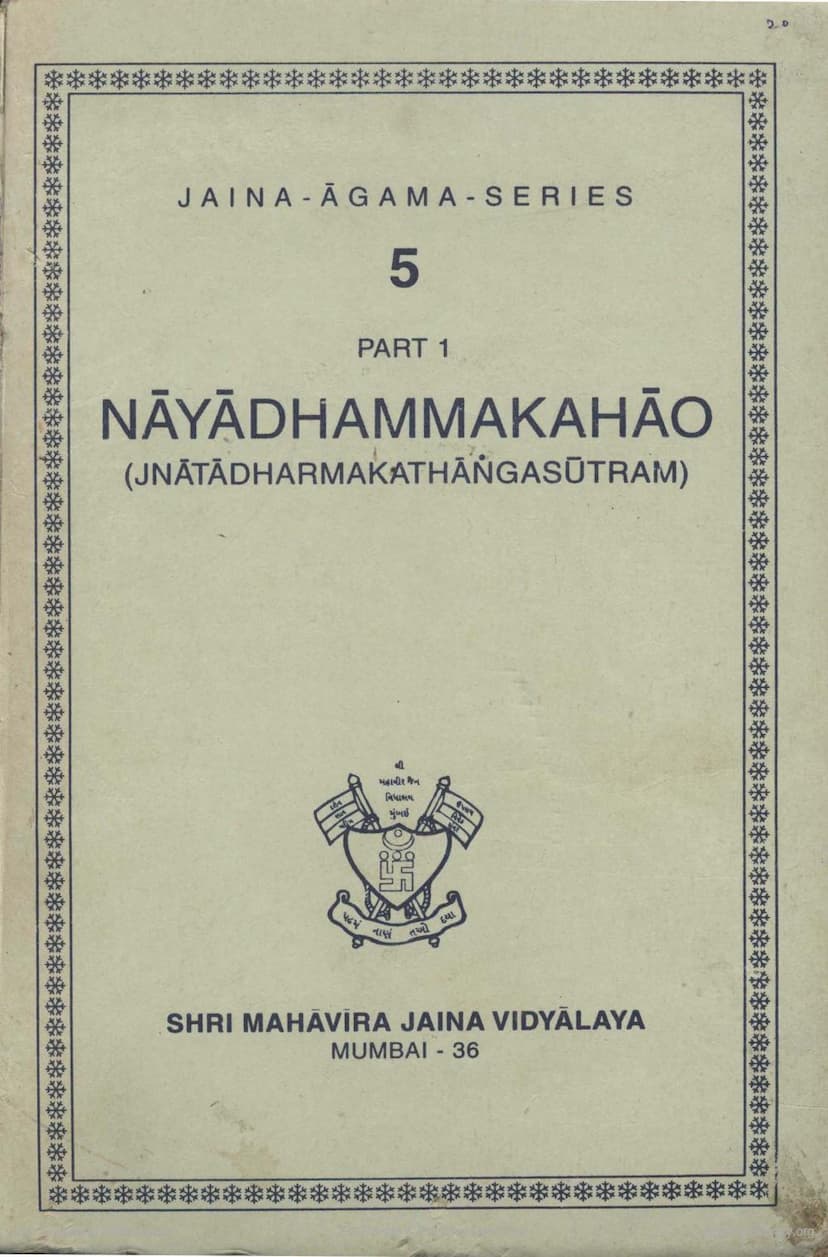Agam 06 Ang 06 Gnatadharma Sutra
Added to library: September 1, 2025

Summary
This is a summary of the Jñātādharmakathāṅga Sūtra, the sixth Anga of the Jain Agamas, based on the provided text.
Book Title: Agam 06 Ang 06 Jñātādharmakathā Sūtram (also referred to as Nāyādhammakāhā) Author(s): Muni Jambūvijaya (Editor), Muni Dharmachandra Vijaya (Assistant Editor) Publisher: Shri Mahavira Jaina Vidyalaya, Mumbai Publication Year: V.S. 2046 / 1989 CE
Overview:
The Jñātādharmakathāṅga Sūtra is the sixth text in the twelve Angas of the Jain Agamas. It is a collection of stories and narratives that illustrate Jain principles and teachings. The text is attributed to Lord Mahāvīra in terms of its meaning and doctrine, and to the Gaṇadharas (specifically Sudharmasvāmi, the fifth Gaṇadhara, according to the Svetāmbara tradition) in terms of its compilation and textual structure. The work is primarily in prose, interspersed with verses.
Content and Structure:
The Jñātādharmakathāṅga Sūtram consists of two Śrutaskandhas (parts):
-
First Śrutaskandha (Jñāta): This section contains nineteen chapters (adhyayanas), each presenting a narrative or illustration (jñāta). These stories often focus on the consequences of actions, the importance of right conduct (samya-charitra), and the pitfalls of attachment to worldly desires and sensory pleasures. The narratives are rich in detail about the social, cultural, and religious life of the period, providing insights into customs, beliefs, and practices. The text highlights the principles of karma, reincarnation, and the path to liberation through ethical conduct and spiritual discipline. Many of the stories involve historical or legendary figures, illustrating profound moral lessons. The editor, Muni Jambūvijaya, has provided extensive commentary and notes to elucidate the text, its context, and its significance.
-
Second Śrutaskandha (Dharmakathā): This section contains ten classes (vargas) of religious stories. The text mentions a vast number of stories and sub-stories within this section, although much of this vast narrative corpus is now considered lost or fragmented. The stories in this section often involve divine beings (devas) and their interactions, serving as further illustrations of Jain principles, especially regarding the consequences of actions and the path to spiritual advancement.
Key Themes and Teachings:
- Karma and Rebirth: The narratives consistently emphasize the law of karma, demonstrating how actions (good or bad) have consequences in this life and future lives. The stories illustrate the cycle of birth, death, and rebirth, and how righteous conduct leads to favorable destinations, while unrighteous conduct leads to suffering.
- Right Conduct (Samya-charitra): Jain principles of non-violence (ahimsa), truthfulness (satya), non-stealing (asteya), celibacy (brahmacharya), and non-possession (aparigraha) are interwoven throughout the stories. The consequences of adhering to or deviating from these principles are often vividly portrayed.
- Detachment and Renunciation: Many stories highlight the importance of detachment from worldly pleasures, possessions, and relationships as a means to achieve spiritual liberation (moksha). Narratives of ascetics and virtuous individuals who renounce the world are common.
- Moral Lessons: The Jñātādharmakathā is essentially a didactic text, using engaging narratives to teach moral and ethical values. The stories often conclude with a moral or a direct sermon from a spiritual master, guiding the reader towards a virtuous life.
- Cultural and Historical Insights: The text provides valuable glimpses into the socio-cultural landscape of ancient India, including details about cities, royal courts, social customs, economic activities (like trade), medical practices, artistic expressions (like sculpture and architecture), and religious practices of various sects.
- The Power of Intentions: The narratives often emphasize the significance of intention (bhava) behind actions, showing how even seemingly minor intentions can have far-reaching karmic consequences.
Editorial and Scholarly Apparatus:
The edition by Muni Jambūvijaya and Muni Dharmachandra Vijaya is a scholarly critical edition. It includes:
- Extensive Introduction (Āmukham): Providing context on authorship, title, content, style, manuscripts used, and a detailed analysis of various aspects of the text.
- Critical Footnotes: Explaining textual variants, clarifying obscure terms, and providing references to other scriptural and scholarly works.
- Appendices: Six appendices offer valuable supplementary information, including a word-index, an alphabetical index of verses, explanations of passages suggested by 'va', lists of upanayagāthās (illustrative verses), and important textual corrections.
- Manuscript Collation: The editors have utilized a wide range of ancient palm-leaf and paper manuscripts from various Jain Bhandaras to produce a critical and reliable text.
Significance:
The Jñātādharmakathā is considered a vital text for understanding the practical application of Jain philosophy in daily life. Its narrative style makes complex ethical and spiritual concepts accessible to a wider audience. The text not only imparts religious and moral teachings but also serves as a historical and cultural document of ancient Indian society, particularly within the Jain tradition. The detailed critical edition by Shri Mahavira Jaina Vidyalaya, with its extensive scholarly apparatus, makes this important text more accessible to modern readers and researchers.